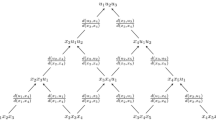Abstract
We present a general framework for a higher-order spline level-set (HLS) method and apply this to biomolecule surfaces construction. Starting from a first order energy functional, we obtain a general level set formulation of geometric partial differential equation, and provide an efficient approach to solving this partial differential equation using a C 2 spline basis. We also present a fast cubic spline interpolation algorithm based on convolution and the Z-transform, which exploits the local relationship of interpolatory cubic spline coefficients with respect to given function data values. One example of our HLS method is demonstrated, which is the construction of biomolecule surfaces (an implicit solvation interface) with their individual atomic coordinates and solvated radii as prerequisites.
Similar content being viewed by others
References
Osher S, Fedkiw R. Level Set Method and Dynamic Implicit Surfaces. New York: Springer, 2003.
Sethian J A. Level Set Methods and Fast Marching Methods: Evolving Interfaces in Computational Geometry, Fluid Mechanics, Computer Vision, and Materials Science. Cambridge Monographs on Applied and Computational Mathematical, Second edition, Cambridge University Press, 1999.
Osher S, Sethian J. Fronts propagating with curvature-dependent speed: Algorithms based on Hamilton-Jacobi formulations. Journal of Computational Physics, 1988, 79(1): 12–49.
Sanner M, Olson A, Spehner J. Reduced surface: An efficient way to compute molecular surfaces. Biopolymers, 1996, 38(3): 305–320.
Connolly M. Analytical molecular surface calculation. J. Appl. Cryst., 1983, 16(5): 548–558.
Richards F M. Areas, volumes, packing, and protein structure. Ann. Rev. Biophys. Bioeng., 1997, 6: 151–176.
Liang J, Edelsbrunner H, Fu P, Sudhakar P V, Subramaniam S. Analytical shape computation of macromolecules: I. molecular area and volume through Alpha shape. Proteins: Structure, Function, and Genetics, 1998, 33(1): 1–17.
Cazals F, Proust F. Revisiting the description of Protein-Protein interfaces, part I: Algorithms. Research Report 5346, INRIA, 2004.
Cazals F, Proust F. Revisting the description of Protein-Protein interface, part II: Experimental study. Research Report 5501, INRIA, 2005.
Cazals F, Proust F, Bahadur R P, Janin J. Revisiting the Voronoi description of Protein-Protein interfaces. Protein Sci., 2006, 15(9): 2082–2092.
Akkiraju N, Edelsbrunner H. Triangulating the surface of a molecule. Discr. Appl. Math., 1996, 71(1-3): 5–22.
Liang J, Edelsbrunner H, Fu P, Sudhakar P V, Subramaniam S. Analytical shape computation of macromolecules: II. inaccessible cavities in protein. Proteins: Structure, Function, and Genetics, 1998, 33(1): 18–29.
Edelsbrunner H. Deformable smooth surface design. Discrete & Computational Geometry, 1999, 21(1): 87–115.
Cheng H-L, Dey T K, Edelsbrunner H, Sullivan J. Dynamic skin triangulation. Discrete & Computational Geometry, 2001, 25(4): 525–568.
Bajaj C, Lee H, Merkert R, Pascucci V. NURBS based B-rep Models from Macro-molecules and their properties. In Proc. Fourth Symposium on Solid Modeling and Applications, 1997, pp.217–228.
Bajaj C, Pascucci V, Shamir A, Holt R, Netravali A. Dynamic maintenance and visualization of molecular surfaces. Discrete Applied Mathematics, 2003, 127(1): 23–51.
Blinn J. A generalization of algebraic surface drawing. ACM Transactions on Graphics, 1982, 1(3): 235–256.
Duncan B S, Olson A J. Shape analysis of molecular surfaces. Biopolymers, 1993, 33(2): 231–238.
Grant J, Pickup B. A Gaussian description of molecular shape. Journal of Phys. Chem., 1995, 99(11): 3503–3510.
Zhang Y, Xu G, Bajaj C. Quality meshing of implicit solvation models of biomolecular structures. Computer Aided Geometric Design, 2006, 23(6): 510–530.
Baker N, Sept D, Joseph S, Holst M, Mc-Cammon J. Electrostatics of nanosystems: Application to microtubules and the ribosome. In Proc. Natl. Acad. Sci., USA, 2001, pp.10037–10041.
Holst M, Saied F. Multigrid solution of the Poisson-Boltzmann equation. J. Comput. Chem., 1993, 14(1): 105–113.
Bajaj C L, Xu G, Zhang Q. Smooth surface constructions via a higher-order level-set method. ICES Report 06-18, Institute for Computational and Engineering Sciences, The University of Texas at Austin, 2006.
Faugeras O D, Keriven R. Variational principles, surface evolution, PDE’s, level-set methods, and the stereo problem. IEEE Trans. Image Process., 1998, 7(3): 336–344.
Xu G, Zhang Q. Construction of geometric partial differential equations in computational geometry. Mathematica Numerica Sinica, 2006, 28(4): 337–356.
Osher S, Shu C W. High-order essentially nonoscillatory schemes for Hamilton-Jacobi equations. SIAM Journal of Numerical Analysis, 1991, 28(4): 907–922.
Peng D, Merriman B, Osher S, Zhao H, Kang M. A PDE-based fast local level set method. Journal of Computational Physics, 1999, 155(2): 410–438.
Bajaj C L, Djeu P, Siddavanahalli V, Thane A. Texmol: Interactive visual exploration of large flexible multi-component molecular complexes. In Proc. the Annual IEEE Visualization Conference'04, Austin, Texas, USA, 2004, pp.243–250.
Author information
Authors and Affiliations
Corresponding author
Additional information
Bajaj is supported in part by NSF of USA under Grant No. CNS-0540033 and NIH under Grant Nos. P20-RR020647, R01-EB00487, R01-GM074258, R01-GM07308. Xu and Zhang are supported by the National Natural Science Foundation of China under Grant No. 60773165 and the National Basic Research 973 Program of China under Grant No. 2004CB318000. Zhang is also supported by Beijing Educational Committee Foundation under Grant No. KM200811232009.
Electronic supplementary material
Below is the link to the electronic supplementary material.
Rights and permissions
About this article
Cite this article
Bajaj, C.L., Xu, GL. & Zhang, Q. Higher-Order Level-Set Method and Its Application in Biomolecular Surfaces Construction. J. Comput. Sci. Technol. 23, 1026–1036 (2008). https://doi.org/10.1007/s11390-008-9184-1
Received:
Revised:
Published:
Issue Date:
DOI: https://doi.org/10.1007/s11390-008-9184-1




